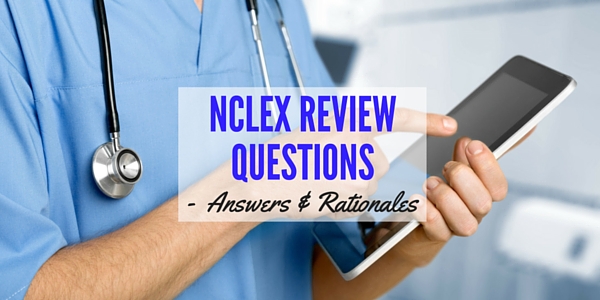Respiratory
#1. Answer: C
Rationale:
Getting the oxygen saturation through a pulse oximeter is quick and easy. This is a non-invasive test and is the ideal tool to determine episodes of failing respiratory function requiring immediate intubation. Peak Flow Meter evaluates lung capacity by measuring how well air is expelled from the lungs but it cannot determine tissue perfusion rate or oxygen saturation levels. The most important determinant to initiate intubation is the percentage of oxygen in the blood. Although Partial Oxygen Saturation in Arterial Blood Gas is a more accurate reading of oxygen saturation, obtaining ABG before an intubation is time-wasting and cause treatment delay. It is not an ideal measurement tool in an emergency set-up. Lung Function test is a series of breathing tests that measures total lung capacity. This does not measure the amount of oxygen present in tissues/cells.
>>NCLEX Review Questions — Test Yourself! (Parts 1-4)<<
#2. Answer: C
Rationale:
Trachea-innominate artery fistula is secondary to a malpositioned tube. Continuous pressure from the distal tip pushing against the lateral wall of the tracheostomy causes death of tissues and erosion of innominate artery. This condition is a life threatening complication and is considered as a medical emergency. Common manifestations are synchronous tracheostomy tube pulsation with heartbeat and heavy bleeding in the stoma.
>>NCLEX Review Questions — Test Yourself! (Parts 1-4)<<
#3. Answer: D, E, F
Rationale:
The client should breathe in slowly and deeply to allow effective inhalation of the medication. If the spacer makes a whistling sound, the client is breathing too rapidly. After breathing in, remove the mouthpiece and while keeping the lips closed, the client is asked to hold the breath for at least 10 seconds and then breathe out slowly. The client should wait at least 1 minute between puffs not 30 seconds.
>>NCLEX Review Questions — Test Yourself! (Parts 1-4)<<
#4. Answer: A, B, E
Rationale:
Loading of drug depends on the type of dry powder inhaler. Take note that some dry powder inhalers do not require loading. Dry powder inhalers are kept dry always and are place at room temperature. After breathing in, remove the inhaler from your mouth and exhale. Never exhale into the inhaler because the client’s breath will moisten the powder causing it to clump and not be delivered accurately.
>>NCLEX Review Questions — Test Yourself! (Parts 1-4)<<
#5. Answer: C
Rationale:
Current first line therapy drugs for Tuberculosis are isoniazid (INH) and rifampin. The disease is usually no longer contagious after the drugs have been taken for 2 to 3 consecutive weeks. With strict adherence to the prescribed drug regimen, treatment is usually lessened to 6 months.
>>NCLEX Review Questions — Test Yourself! (Parts 1-4)<<
#6. Answer: D
Rationale:
Food and antacids slow or prevent absorption of the drug from the GI tract. Teach the client to take the drug on an empty stomach and avoid antacids. Isoniazid (INH) can deplete vitamin B-complex stores of the body. It is recommended to advise the client to take a daily multivitamin that contains the B-complex vitamins while on Isoniazid. Alcoholic beverages are contraindicated while on this drug. Isoniazid can cause liver damage. This effect is potentiated by alcohol. Option D is correct because these are manifestations that indicate liver toxicity or failure.
>>NCLEX Review Questions — Test Yourself! (Parts 1-4)<<
#7. Answer: B, E, F
Rationale:
a. Administer salicylates.
Salicylates increase anticoagulant effects and should be avoided while on heparin therapy.
b. Monitor platelets daily for thrombocytopenia.
Heparin-induced thrombocytopenia (HIT), a type of arterial thrombosis, can occur.
c. Have the antidote vitamin k available.
Antidote for heparin toxicity is protamine sulfate.
d. Use firm toothbrushes.
Avoid the use of firm toothbrushes, straight razors, and rectal thermometer to help prevent bleeding.
e. Monitor partial thromboplastin time (PTT).
Ongoing assessment helps detect side effects and prevent complications. Reporting and monitoring enables the physician to begin early treatment of a prolonged PTT and excessive bleeding.
f. Re-bolus every time infusion is increased.
This is done to maintain anticoagulation within consistent therapeutic levels.
>>NCLEX Review Questions — Test Yourself! (Parts 1-4)<<
#8. Answer: A, C, F
Rationale:
a. The therapeutic range of partial prothrombin time for pulmonary embolism is 1.5 to 2.5 times than the normal value
Common normal ranges are 20 to 30 seconds in some laboratories and 30 to 40 seconds in others. If the normal is 20 to 30 seconds, then the therapeutic range is 40 to 75 seconds.
b. The therapeutic range of prothrombin time for pulmonary embolism is 11 to 12.5 sec.
11 to 12.5 seconds is the normal range of prothrombin time. The normal range for anticoagulant therapy in pulmonary embolism is 1.5 to 2 times the normal or control value in seconds.
c. International normalized ratio (INR) therapeutic range for pulmonary embolism is 2.5 to 3.0 or 3.0 to 4.5 for recurrent pulmonary embolism
International normalized ratio (INR) values may be reported with the prothrombin time.
d. PTT is use to monitor warfarin therapy and PT is used to monitor Heparin Therapy
Partial thromboplastin time is used to monitor heparin therapeutic levels while prothrombin time is used to monitor warfarin therapeutic levels.
e. Prolonged values of prothrombin time may signify that the client is not receiving enough warfarin and an increase dose is usually indicated.
Prolonged PT values in the treatment of pulmonary embolism indicates that the client is at risk for bleeding. Warfarin dose is usually decreased or held, the client is instructed to eat foods high in vitamin K, or an injection of vitamin K may be given. Option e is indicating the effects of subtherapeutic levels of PT.
f. Prolonged times of partial thromboplastin time in clients with pulmonary embolism (>75 sec) indicates that the client is at risk for serious spontaneous bleeding.
Heparin is usually held or decreased until the PTT drops back into therapeutic range.
>>NCLEX Review Questions — Test Yourself! (Parts 1-4)<<
#9. Answer: B
Rationale:
Option A is Class II Primary Pulmonary Hypertension, option C is Class IV Primary Pulmonary Hypertension, and option D is Class I Primary Pulmonary Hypertension.
>>NCLEX Review Questions — Test Yourself! (Parts 1-4)<<
Psychiatric
#10. Answer: D
Rationale:
Option A is the action of Gamma-Amino Butyric acid (GABA), option B is the action of norepinephrine, and option C is the action of serotonin.
>>NCLEX Review Questions — Test Yourself! (Parts 1-4)<<
#11. Answer: B
Rationale:
Option A is correct because delirium usually happens few hours to 1 month only. With delirium, there is a disturbance in perception involving the 5 senses, which makes option C correct. Since there is a disturbance with sensation and perception, safety is a major concern, which makes option D correct. Option B is not an appropriate nursing diagnosis for delirium because it is a nursing diagnosis for dementia which can last up to 6 months or longer.
>>NCLEX Review Questions — Test Yourself! (Parts 1-4)<<
#12. Answer: D
Rationale:
Option A refers to insomnia, option B refers to sleep deprivation, while option C refers to Obstructive Sleep Apnea Syndrome.
>>NCLEX Review Questions — Test Yourself! (Parts 1-4)<<
#13. Answer: B
Rationale:
Unconscious is the storage of painful memories and also called method of recalling. Pre-conscious is the watchman of the mind which is consist of partly forgotten and partly remembered memories. Conscious happens when a person is awake. Transference happens when the feelings of the client is transferred to the healthcare provider.
>>NCLEX Review Questions — Test Yourself! (Parts 1-4)<<
#14. Answer: C
Rationale:
Clients with delirium experienced Visual Hallucination. Clients with schizophrenia often experienced Auditory Hallucination. Clients with Acute Alcohol Withdrawal can experience Tactile Hallucination.
>>NCLEX Review Questions — Test Yourself! (Parts 1-4)<<
#15. Answer: B
Rationale:
In Somatoform Disorder, there is no real organ damage, but the client verbalizes presence of symptoms of a disease in an unconscious manner. In Malingering, there is no real organ damage, but the client verbalizes presence of symptoms of a disease in a conscious manner to achieve a secondary gain or benefit. Anxiety comes in many forms. The distinction between a disorder and “normal” anxiety isn’t always clear. Amnesia refers to the loss of memories, such as facts, information and experiences.
>>NCLEX Review Questions — Test Yourself! (Parts 1-4)<<
Cardiology
#16. Answer: B
Rationale:
Atrial flutter occurs in the atrium and creates pulses at an arterial rate between 250 to 350 times per minute; ventricular rate usually ranges between 70 to 150. P:QRS ratio can be 2:1, 3:1 or 4:1 and P wave is saw toothed in shape and referred to as F waves. Premature Atrial Complex (PAC) occurs when an electrical impulse commence in the atrium before the next normal impulse of the sinus node. Ventricular and arterial rate depends on the underlying rhythm (example sinus bradycardia), P:QRS ratio is usually 1:1 and P wave may be hidden in the T wave.
Supraventricular Tachycardia (SVT) involves the rapid stimulation of the atrial tissue at a rate of 100 to 280 beats/min in adults and 200 to 300 beats/min in children. Ventricular rate usually ranges between 75 to 250, P:QRS ratio can be 1:1 or 2:1 and P waves are difficult to see or may not be seen. Atrial Fibrillation is the most common dysrhythmia. In clients with atrial fibrillation, multiple rapid impulses from an arterial foci depolarize the atria in a totally disorganized manner at a rate of 350 to 600 times per minute; ventricular rate is usually 120 to 200 in untreated arterial fibrillation and there is no clear P wave and P:QRS ratio is usually 1.
>>NCLEX Review Questions — Test Yourself! (Parts 1-4)<<
#17. Answer: C
Rationale:
Clients who had undergone mitral valve replacement should avoid invasive dental procedures or any dental work for 6 months because of the potential for endocarditis. Most clients can usually return to normal activity after 6 weeks but should avoid heavy physical labor with their upper extremities for 3 to 6 months to allow incision to heal. The client is at risk for infective endocarditis, that’s why preventive measures should be implemented through collaborative care by notifying all healthcare providers. Antibiotic prophylaxis before and after any invasive procedure or test is necessary to prevent infective endocarditis.
>>NCLEX Review Questions — Test Yourself! (Parts 1-4)<<
#18. Answer: A, B, E, F
Rationale:
a. Auscultate for a pericardial friction rub.
Pericardial friction rub may be heard with the diaphragm of the stethoscope positioned on the left lower sternal boarder.
b. Provide anti-inflammatory agents as prescribed.
Anti-inflammatory medication will decrease the pain usually within 48 hours.
c. Inspect for other indications of cardiac tamponade such as collapse neck veins with clear lung, clear audible heart sound and increase in cardiac output.
Other indications of cardiac tamponade includes jugular vein distention with clear lungs, muffled heart sound and decrease cardiac output
d. Aspirin may be given to the client.
Aspirin and anticoagulants are avoided because these drugs may increase the possibility of cardiac tamponade.
e. Auscultate the blood pressure carefully to detect paradoxical blood pressure (pulsus paradoxus).
Pulsus paradoxus is a sign usually detected for clients with cardiac tamponade.
f. Assess the nature of the client’s chest discomfort.
Pericardial pain is typically substernal. It is worse on inspiration and decreases when the client leans forward.
>>NCLEX Review Questions — Test Yourself! (Parts 1-4)<<
#19. Answer: B
Rationale:
Unlike left and right sided heart failure, high-output heart failure occurs when cardiac output remains normal or above normal, which are typically low-output states. This is caused by increased metabolic needs or hyperkinetic conditions such as septicemia (fever), anemia, and hyperthyroidism. Right-sided heart (ventricular) failure is secondary to right ventricular MI, left ventricular failure, or pulmonary hypertension. In this type of heart failure (HF), the right ventricle cannot empty completely. Increased volume and pressure develops in the venous system and results to peripheral edema. Systolic ventricular dysfunction results when the heart cannot contract forcefully enough to deliver adequate amounts of blood into the circulation. As a result of increased peripheral resistance, preload increases with decreased contractility and afterload increases. Diastolic heart failure or heart failure with preserved left ventricular function occurs when the left ventricle cannot relax adequately during diastole. Stiffening or inadequate relaxation prevents the ventricle from filling with sufficient blood.
>>NCLEX Review Questions — Test Yourself! (Parts 1-4)<<
#20. Answer: C
Rationale:
Troponin is a myocardial cell protein that is elevated in the serum during a myocardial infarction (MI). Greater levels of Troponin indicate severe heart damage. Options A, B and D are not useful in diagnosing MI.
>>NCLEX Review Questions — Test Yourself! (Parts 1-4)<<
Oncology
#21. Answer: A
Rationale:
In managing pain for clients with cancer, the World Health Organization has developed a three-step ladder of pain relief. The first step is composed of non-opioid analgesics such as acetaminophen (Tylenol), aspirin (Ecotrin) and other NSAIDs for client who had just begun experiencing discomfort. The second step is composed of mild opioids like codeine while the third and last step is composed of strong opioids like morphine.
>>NCLEX Review Questions — Test Yourself! (Parts 1-4)<<
#22. Answer: C
Rationale:
The ability of the malignant tumor cells to invade and metastasize is the major difference between benign and malignant neoplasm. The size of the mass is more significant in cancer staging. The modes of neoplasm growth and presence of a capsule are only minor comparison of benign from malignant neoplasm.
>>NCLEX Review Questions — Test Yourself! (Parts 1-4)<<
#23. Answer: D
Rationale:
There are less breast changes occurring after menstruation and is the best time to perform BSE. The breasts are swollen a week before menstruation. There may be lump formation due to normal physiologic processes. Performing BSE before menstruation will yield inaccurate results. Menopausal clients are advised to perform BSE on the first day of every month to keep them reminded of the monthly screening procedure. When BSE is performed during the first day of menstruation, this usually leads to inaccurate results.
>>NCLEX Review Questions — Test Yourself! (Parts 1-4)<<
#24. Answer: C
Rationale:
Complications of Hodgkin’s disease are nausea, infection and deficiency of red blood cells, white blood cells, and platelets. Cardiac conditions do not occur in this disease.
>>NCLEX Review Questions — Test Yourself! (Parts 1-4)<<
#25. Answer: A
Rationale:
Multiple myeloma is characterized by malignant plasma cells that abnormally produce elevated levels of non-functional immunoglobulins. In late stages, red blood cells, white blood cells and platelets are reduced as the malignant cells infiltrate the bone marrow.










![8 Songs That Remind You of Nursing [VIDEO] best songs for nurses](https://www.nursebuff.com/wp-content/uploads/2014/07/best-songs-for-nurses-100x70.jpg)








